![[SoundStage!]](../sslogo3.gif) The Traveler The TravelerBack Issue Article |
August 2002 My Summer Trip to the Lake, or A Visit to Axiom Audio
Axiom Audio started small back in 1980 -- more than likely setting up shop in a very small space -- and then grew. Now they inhabit a sizeable factory. However, they’ve managed to plop themselves down in gorgeous surroundings. They’re the fabled exception to the rule, and their story illustrates the benefits that accrue when you adhere to your own principles and do things on your own terms. Location, location, location… Axiom's factory is located near Algonquin Park, about five hours from Ottawa by car. It’s remote, but it’s a Canadian tourist area of the highest order. Full of trees, lakes, trees, and more lakes, it's probably the most unlikely place that you’ll ever find a high-volume speaker company. But Axiom is there, believe it or not, and the company churns out quite literally tons of very affordable loudspeakers from this location. The large, bustling factory is quite a contrast to its quaint, tranquil surroundings. Conventional logic dictated that Ian Colquhoun needed to locate his factory in Toronto, but he thought otherwise. He stayed where he was -- he grew up nearby and didn’t want to leave-- and made it all work. As a result, he’s built Axiom from one-person shop to the formidable manufacturer it is today. Now that he has made his speakers available over the Internet, people can order from the most remote corners of the world. Axiom is able to build them all and ship them from beautiful Algonquin Park. I doubt he would have foreseen this in 1980, but it goes to show you how things can work out. Ian and Amie Colquhoun’s house is just ten minutes away from the factory -- and once you get to their house, you’ll understand why Ian never wanted to leave. The area is called Muskoka -- "Land of Lakes" -- and Ian’s house is located on beautiful Lake of Bays. I spent the night in a resort cabin just on the other side of the highway. My lake for the day was Walker Lake. When I arrived, Amie was sitting on the dock by their boat with her laptop in hand. Ian never wanted to leave his home when he built the factory there, and now Amie quite literally doesn’t want to leave her home. If you ever see their view, you’ll know why. Despite the factory's just-a-few-minutes-away location, she'd rather do everything online, so their home is her office and, it goes without saying, there is a line to the Internet right off their boat dock. I suspect that they are hoping and praying for a wireless connection some day that will allow Internet access in their boat.
Is it live or is it…? First and foremost, Axiom is a consumer loudspeaker company. Ian’s been building consumer loudspeakers for more than 20 years and listening all that while. As a result, he’s become increasingly disgruntled with the quality of a lot of recorded material. Quite simply, it sounds bad despite the fact that the music on it might be good. Ian told me that back in the '80s Floyd Toole and others used to record live bands in Ottawa and then take the tapes back to NRC so they could have something "close" to a live reference. The sound on some of those recordings, he said, was phenomenal. However, much of what we hear today isn’t. In Ian's words, "I want to get to the bottom of this and see where they’re screwing it up." Building his own recording studio is a step in that direction -- and he knows exactly how he wants to do it. In the province of Quebec there is a resort-like recording studio called Le Studio, located in Morin Heights. The building for the studio sits amidst lavish scenery not unlike Muskoka, and a small house is situated nearby for housing the musicians and staff. It can be the perfect creative environment. Ian knows it well because his speakers were used there in the ‘80s (Canadians may remember the advertisements in the Canadian audio magazines of that era). If he goes ahead with his studio, he wants to model his project on that studio and build it on his own piece of land. He reckons that, with the knowledge that he and his company have gained building loudspeakers (the very back end, so to speak), he may be able to create something worthwhile for the front end. Plus, it would be an awesome place to record for any band willing to make the trek up there -- or perhaps some musicians will decide to merely travel from across the lake. Closing our eyes for a moment Speakers are and will remain Axiom's focus, though, and Ian wanted to show me some new things at the factory that weren’t there the first time I visited. Ian has always had a listening room in his home, but he does his serious comparative listening back at the factory -- and he has just built a new listening room. Not surprisingly, since Ian is a devotee of Floyd Toole’s NRC research, this includes blind listening tests. He has set up his listening room to do comparative evaluations under blind conditions for everything from a single speaker to stereo and even full multichannel surround sound. Through special volume controls, all the channels can be perfectly level-matched -- necessary for this type of testing.
Blind tests of the type Colquhoun and the NRC perform are not like that at all. In fact, the differences are easy to detect and they become almost shockingly obvious -- although the more expensive product doesn’t always win. After all, if the process didn't work, why would companies go to all the trouble to build a room like Axiom's? They don't do it for people like me -- I drop in only once every couple of years. It's for them to evaluate their own designs. The speakers are hidden from view behind an acoustically transparent curtain. The listener can’t see them, but he or she can hear them perfectly. This means that when the listener doesn’t know what’s playing, his prejudices about size, price, technology, etc., have no bearing on the test. All the listener is left with is the sound. Is it good or bad? The listener can leisurely audition a speaker on its own or choose to compare it to a second speaker precisely set to equal volume levels. The tester can listen for one minute or one hour or one day -- it’s up to him. Most of the better speaker companies I have visited do this type of listening as a critical part of their design process since it does an effective job of removing biases. Ian had one of his employees set up the test so even he didn’t know which speakers were playing. At first, Ian simply gave me the controls and a whole bunch of CDs and then he left the room, letting me decide which of the two pairs of speakers I liked more. Let me tell you, I’ve been through a number of blind tests, and each time it’s a daunting task. When those biases I mentioned are removed and you must trust only your ears, it’s a whole new ballgame. And I suspect that if many so-called golden-eared reviewers did a blind test, they’d be in for a rude awakening (and this is one of the reasons, I suspect, why many reviewers like to dismiss the process). Right off the bat I could tell speakers A and B sounded quite a bit different, but which sounded better was what had to be decided. Speaker A had a smooth top end, a clear but laid-back midrange, and its bass was there, but lacking real heft. I felt it was probably a small speaker. Speaker B had some real bass, was more forward in the midrange, and had more sparkle on top. The music was more full, but at the same time, everything was tighter and more precise. I guessed it to be a floorstander or perhaps a satellite with a subwoofer. With some initial thoughts, I did some serious back-and-forth comparisons and came up with some strong conclusions. Although speaker A was good, I found its soundstage to be somewhat diffuse compared to B -- A’s images weren’t as solid. When I switched to B, everything snapped into focus. Speaker B could also play quite a bit louder without strain and remained effortless no matter the volume. With almost all the music I played, speaker B consistently came out the winner -- it was tighter, clearer, and had more extension from top to bottom. In a nutshell, everything simply sounded more "right" with it -- except for one piece of music, and that set me back a bit. Ironically, Ian left Shania Twain’s Come on Over CD [Mercury 536003] in the room, and I played "You’re Still the One" from it. Even though every other disc sounded better on speaker B, this disc, and particularly this track, sounded better on speaker A! Speaker B was too forward, had too much treble, and the bass was no longer coming through as strongly. I went and got Ian so we could discuss it. Ian came back to the room, took the listening chair, and began listening to the two speakers just as I had -- but with a difference.
"Which models," I thought, thoroughly impressed. "I was just trying to figure out which sounded better!" Within a minute he said, "OK, I know which ones these are. What are you hearing?" To make a long story short, we agreed on almost everything, including the fact that Shania Twain’s CD sounded better, or was at least more listenable, on speaker A. "It’s mixed for radio," Ian declared. By that he meant that it’s tipped up in the highs, lacking bass, and is thoroughly devoid of dynamics. Then he unveiled speaker A to be the $275 bookshelf M3Ti SE, and B to be the $1100 floorstanding M80Ti SE. I was right. A was the smaller speaker, and that accounted for the lack of bass. As for the laid-back midrange, Ian says that in comparison to the M80Ti SE, the M3Ti SE is more laid-back. He says that’s a result of the M80Ti SE's better on- and off-axis dispersion. Having that dedicated midrange driver helps with this. In terms of the imaging, he says he has optimized the M80Ti SE’s crossover all he can, and when he did this the imaging improved drastically. Yes, it’s a better speaker, albeit at four times the price. But what about the Shania Twain track? The M80Ti SE is a speaker that will let you have it -- for better or worse. The flatter midrange and highs combined with the overly hot recording technique made for too much of a good thing. The M3Ti SE was more polite and restrained in its presentation, and this helped the recording. So why would the recording label do such a thing? Audiophiles have known about such recordings for years and lament the same sort of things. Radios and boomboxes have poor high-frequency performance and aren’t capable of real dynamics. So recording labels adjust the CDs to compensate! This is why so many discs have overly pronounced highs, no real lows, and a midrangy sound that is completely devoid of dynamics. It’s part of that screwing up that Ian talked about. I suspect that if Shania Twain visits and hears her recordings over a pair of M80Ti SEs, change will be in order. The sound of life I was impressed with the M80Ti SE, so I asked Ian more about it. Before we talked, though, he gave me another ear-opening demo. He put on a rock recording and played the M80Ti SEs at what must have been more than 105dB. It was LOUD -- louder than I’d ever listen. But there was a point to it all. Getting back to recordings and making them sound better, Ian feels one of the things missing in home reproduction is true dynamics. He thinks that many audiophile speakers fall apart when pushed to play too loudly. That’s what he worked hard to overcome with the M80Ti SE -- the flagship of the Axiom line. While some audiophiles may raise their eyebrows at the doubling up of tweeters, midrange drivers, and woofers on that speaker, Ian said that the reason he did this was for unrestrained dynamics -- for music and home theater. In other words, this speaker will play with impressive detail, but will also go as loud as almost anyone needs it to with a notably low level of distortion. For an $1100-per-pair set of speakers, that’s impressive -- even more so when you learn about how Axiom tested the final design. Ian laughed when I expressed surprise at the
level he played the speakers. "Don’t you worry about blowing them up?" As part of the design process, to "stress test" the M80Ti SE, Ian hooked it up to a Bryston 7B amplifier -- a device capable of delivering more than 700W into the speaker's 4-ohm load. Ian's team had prearranged source material and simply left the amplifier playing at just the point of clipping for 100 hours. Following that they checked the speaker thoroughly for any point of failure. With that torture test proofing the final design, Ian feels The M80Ti SE will survive long in the field. Chalk one up for Axiom and Bryston. On the road again I’ve been to a lot of speaker companies, but this trip to Axiom Audio was one of the most interesting. I don’t get to go to the lake often, but this was a good way to do it. I must admit, though, that it’s a bit of a contradiction to see such large-scale manufacturing amidst such a peaceful and gorgeous place. But it just goes to show you what a bit of ingenuity can do. ...Doug Schneider If you want to find out more about Axiom Audio's products, visit the company's website.
|
|
![[SoundStage!]](../sslogo3.gif) All Contents All ContentsCopyright © 2002 SoundStage! All Rights Reserved |
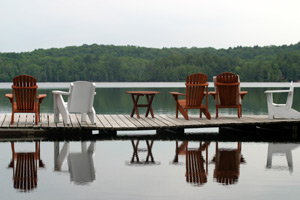 Small loudspeaker companies
are frequently located in very small buildings or even shed-like edifices. Or, if a
speaker company is large, you’ll find it in a huge building more often than not
located in a concrete-laden industrial park. Whatever the size, speaker companies are
almost always located in places that are pretty unattractive and inhuman.
Small loudspeaker companies
are frequently located in very small buildings or even shed-like edifices. Or, if a
speaker company is large, you’ll find it in a huge building more often than not
located in a concrete-laden industrial park. Whatever the size, speaker companies are
almost always located in places that are pretty unattractive and inhuman.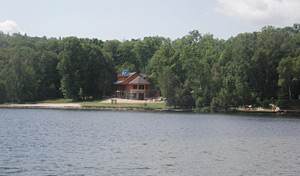 One of the Colquhouns'
newest neighbors is Shania Twain -- yes, that Shania Twain. She grew up in northern
Ontario and is now going to call this one of her homes. She’s bought three
plots of land directly across the lake from Ian and Amie and has just finished building a
huge house on one of them. Presumably, she bought the other two in case she has guests or
perhaps just because she wants more privacy. But who knows? She may well come to visit Ian
and Amie once she finds out what Ian hopes to build on his side of the lake.
One of the Colquhouns'
newest neighbors is Shania Twain -- yes, that Shania Twain. She grew up in northern
Ontario and is now going to call this one of her homes. She’s bought three
plots of land directly across the lake from Ian and Amie and has just finished building a
huge house on one of them. Presumably, she bought the other two in case she has guests or
perhaps just because she wants more privacy. But who knows? She may well come to visit Ian
and Amie once she finds out what Ian hopes to build on his side of the lake.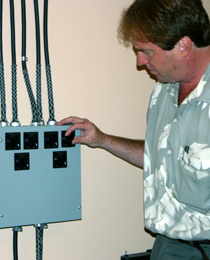 Many audiophiles eschew the
concept of blind listening, but most of these people don’t really understand the
concept. What they confuse it with is double-blind A/B/X-type testing, where someone is
placed in the stressful situation of listening to components being switched back and forth
and then required to make rapid decisions as to whether a difference was detected
or not. More often than not, those types of tests come out with random results that prove
to the tester that no audible differences are apparent -- even if they should have
heard some.
Many audiophiles eschew the
concept of blind listening, but most of these people don’t really understand the
concept. What they confuse it with is double-blind A/B/X-type testing, where someone is
placed in the stressful situation of listening to components being switched back and forth
and then required to make rapid decisions as to whether a difference was detected
or not. More often than not, those types of tests come out with random results that prove
to the tester that no audible differences are apparent -- even if they should have
heard some.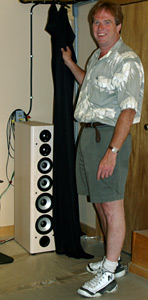 "Let me figure out
which models these are," he said.
"Let me figure out
which models these are," he said. 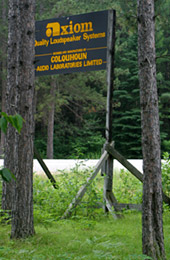 He reassured me that they’re never
going to get damaged that way, providing your amplifier is delivering clean power.
He reassured me that they’re never
going to get damaged that way, providing your amplifier is delivering clean power.